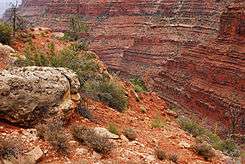Supai Group
The Pennsylvanian to Lower Permian, (end of the Paleozoic Era), Supai Group, is a slope-forming section of red bed deposits found at the southwest-to-south Colorado Plateau. Cliff-forming interbeds (sandstone) are noticeable throughout the group, as well as the largest cliff-former the topmest member Esplanade Sandstone. The Supai Group is especially exposed throughout the Grand Canyon in northwest Arizona, as well as local regions of southwest Utah (Virgin River valley region). It outcrops southeastwards in Arizona at Chino Point (south Aubrey Valley), Sycamore Canyon, and famously at Sedona as parts of Oak Creek Canyon. In the Sedona region, it is overlain by the Hermit Formation, and the colorful Schnebly Hill Formation.
| Supai Group (”redbeds”) Stratigraphic range: Pennsylvanian–Lower Permian, 318–287 Ma | |
|---|---|
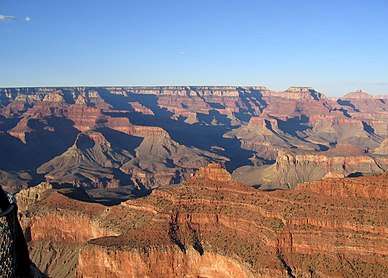 Example Supai red beds, north projecting ridgeline, South Rim, Grand Canyon | |
| Type | Geologic group |
| Sub-units | 4 named subunits: 4-Esplanade Sandstone 3-Wescogame Formation 2-Manakacha Formation 1-Watahomigi Formation, and Pakoon Limestone, of Nevada, Utah, and Arizona |
| Underlies | Hermit Formation-(Permian), Grand Canyon (Hermit elsewhere in Arizona): (west)-Oak Creek Canyon region, Sedona, AZ (townsite)) |
| Overlies | Redwall Limestone-(locally in Grand Canyon)[1] Surprise Canyon Formation Naco Formation-(south and southeast Arizona) Mogollon Rim region-(central Arizona)[2] |
| Thickness | 1,000 feet (300 m) approximate maximum[3] |
| Lithology | |
| Primary | sandstone, siltstone, mudstone |
| Location | |
| Region | (southwest)-Colorado Plateau: basement rocks of Verde Valley, Mogollon Rim, etc. AZ, also, |
| Country | |
| Extent | Extreme southwest Utah (Virgin River valley region), in Arizona: Grand Canyon, Sycamore Canyon, Verde Valley, and buried units at south of Colorado Plateau |
The Supai Group is coeval with the Hermosa Group of east and south Utah; the Hermosa Group extended southeastwards from Utah to Durango,[4] extreme southwest Colorado, and adjacent to the Hermosa type section.
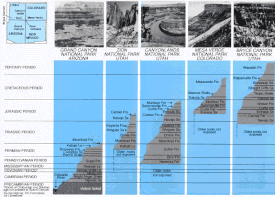
Geology of the 4 member units
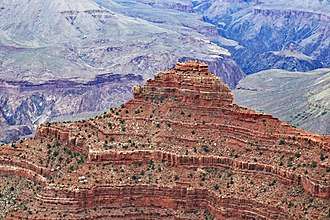
note resistant (vertical) subcliffs in the many layers (formations) of the Supai ”redbeds”.
The oldest member (Early Pennsylvanian), the Watahomigi Formation is from sedimentary basins. It is composed of red mudstone, sandstone, and tan limestone.[5] As ocean levels rose, basins filled, and the Manachka Formation was laid down (especially in the Grand Canyon). Continentally aeolian sand became more widespread; the coeval Weber Sandstone was deposited in northeast Utah (Dinosaur National Monument region, northeast of the Uncompahgre Uplift).[6]
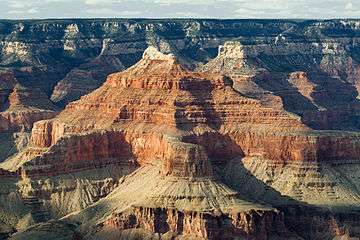
(photo from 2-mi south on Tonto Trail, S. Granite Gorge).[7]
From Middle to Late Pennsylvanian, the Ancestral Rocky Mountains, the northeast spur from Colorado, (the Uncompahgre Uplift) became the source region for further continental river and stream deposits. Rising sea levels and erosion led to the deposition of the Wescogame Formation, (Grand Canyon) by Late Pennsylvanian time, and in east Utah, (Paradox Basin, southwest of Uncompahgre Uplift, the Honaker Trail Formation); northeast of the Uncompahgre Uplift, the Weber Sandstone continued deposition.
By Permian time, the Esplanade Sandstone (Supai Group member 4) was being laid down in northwest Arizona (Grand Canyon), and southwest Utah;[8] the coeval Cedar Mesa Sandstone was being deposited in east Utah.
Geologic sequence
The geologic sequences of the coeval Supai and Hermosa Groups.[9]
|
|
Geologic sequence
The Late Pennsylvanian-Early Permian geologic sequence of the Supai Group common in the Grand Canyon:[11] The Pennsylvanian is the Late Carboniferous.
- Supai Group
- Esplanade Sandstone
- Wescogame Formation
- Manakacha Formation
- Watahomigi Formation
The Supai Group members were created from marine (oceanic) sequences of marine transgression, and regression, thus the alternating sandstone, siltsones, conglomerate subsections (facies); the subsections are not always a continuous transition into the above section, mostly due to ocean levels, falling, or rising, glaciation, or regional subsidence-(basins, etc.) or uplift of land. Today's Wasatch Front is the approximate lineage, NNE to SSW of the western coast region of North America from where the oceans transgressed. The ancient Antler Mountains-(Antler orogeny, off-shore volcanic island arch(es)), of ancient Nevada supplied material, from the west, off the 'ancestral' West Coast. The continent supplied material from the east, both directions supplying the offshore basin, the Cordilleran Basin which became part of the Basin and Range Province, in later epochs. Three other basins were involved in this history: southwest of the Ancestral Rocky Mountains was the Paradox Basin-(eastern Utah to Southwest Colorado), northeast was the Central Colorado Basin-(NW Colorado, NE Utah, SW Wyoming); the Oquirrh Basin was north-northwest, at present day northwest Utah.
Supai Group and Hermosa Group, coeval units
The coeval Supai and Hermosa Groups, Arizona, Utah, and northwest Colorado:[12]
| Arizona — Grand Canyon & central-northeast AZ |
Utah — east and southeast | Uncom- compahgre Uplift |
(northeast)-UT (northwest)-CO (proto)-Uintah Basin region |
|---|---|---|---|
| Supai Group ~330-(318) to 285 Ma |
Hermosa Group | "Ancestral Rocky Mtns" (eroded to sea level, 165 Ma)[13] |
Hermosa Group |
| 4-Esplanade Sandstone-(Grand Canyon & Verde Valley region) | Cedar Mesa Sandstone | "Ancestral Rocky Mtns" | xxxxxxx |
| 3B-Pakoon Limestone-(west)-Grand Canyon, & NV | Elephant Canyon Formation-(east and southeast) Utah | "Ancestral Rocky Mtns" | Hermosa members? |
| 3-Wescogame Formation | (Hermosa) | "Ancestral Rocky Mtns" | Hermosa members? |
| 2-Manakacha Formation | (Hermosa) | "Ancestral Rocky Mtns" | Hermosa members? |
| 1-Watahomigi Formation | (Hermosa) | "Ancestral Rocky Mtns" | Hermosa members? |
| Uncom- compahgre Uplift |
|||
Because marine transgressions cover distances, over time, the coeval units are separated by distance, and type of deposition material; the local subsidence, or uplift, as well as glaciation, and sea level changes, can cause variations in the deposition sequences of transgression-regressions. The ocean was to the west of the proto-North American continent, but also northwest, or southwest.
References
| Wikimedia Commons has media related to Supai Group. |
- Geologic Map of the Grand Canyon in the Vicinity of the South Rim Visitor Center, based on: Geologic map of the eastern part of the Grand Canyon National Park, Arizona, P. W. Huntoon and others, (c. 1995, Grand Canyon Association), (from Geologic Highway Map of Arizona, from Reynolds, c. 1988).
- Blakey, Ranney, 2008. Ancient Landscapes of the Colorado Plateau, from Correlation of the Permian rock units from Chino Point near Seligman, to Fossil Creek southeast of Sedona (Mogollon Rim), p. 129 (graphic).
- Blakey, Ranney, 2008. Ancient Landscapes of the Colorado Plateau, p. XVIII.
- Blakey, Ranney, 2008. Ancient Landscapes of the Colorado Plateau, "Geologic X-sections", (cross-sections), p. XVIII. Type section, pg. 54.
- Blakey, Ranney, 2008. Chapter 4, (Pennsylvanian-Permian), pp. 29-55, p. 31.
- Blakey, Ranney, 2008. Chapter 4, (Pennsylvanian-Permian), p. 31.
- Arizona Road & Recreation Atlas, c. 1998, Map: The Grand Canyon, pp. 12-13.
- Esplanade Sandstone, geologic sequence, southwest Utah
- Blakey, Ranney, 2008. Ancient Landscapes of the Colorado Plateau, p. XVIII, Chapter 4, pg. 54.
- Blakey, Ranney, 2008. Ancient Landscapes of the Colorado Plateau, from Chapter 4, Continental Unrest and Geologic Cycles: Pennsylvanian and Permian, 318 to 251 Million Years Ago, pp. 29-55, p. 54.
- Blakey, Ranney, 2008. Ancient Landscapes of the Colorado Plateau, p. XVIII.
- Blakey, Ranney, 2008. Ancient Landscapes of the Colorado Plateau, "Geologic X-sections", (cross-sections), p. XVIII.
- Blakey, Ranney, 2008. Ancient Landscapes of the Colorado Plateau, 165 Ma map: (upper)-Carmel Formation, with Sundance Sea, p. 76, and p. 78.
- Arizona Road & Recreation Atlas, Benchmark Maps, 2nd Edition, c. 1998, 112 pages, Map: The Grand Canyon, pp. 12–13.
- Blakey, and Ranney, 2008. Ancient Landscapes of the Colorado Plateau, Ron Blakey, Wayne Ranney, c 2008, Grand Canyon Association (publisher), 176 pages, with Appendix, Glossary, Index. Contains approximately 75 shaded topographic maps, for geology, etc., with 54 (23 pairs, (46)) for Colorado Plateau specifically; others are global, or North American.
- Lucchitta, 2001. Hiking Arizona's Geology, Ivo Lucchitta, c 2001, Mountaineers's Books. (softcover, ISBN 0-89886-730-4)
External links
|
|

